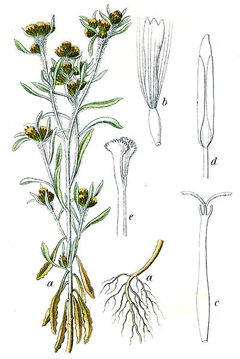 |
|
http://commons.wikimedia.org/wiki/File:Gnaphalium_uliginosum_Sturm26.jpg |
 |
| http://commons.wikimedia.org/wiki/User:BerndH |
Translate this page:
Summary
Physical Characteristics

 Gnaphalium uliginosum is a ANNUAL growing to 0.2 m (0ft 8in) by 0.2 m (0ft 8in). It is in flower from July to August. The species is hermaphrodite (has both male and female organs) and is pollinated by Insects.
Gnaphalium uliginosum is a ANNUAL growing to 0.2 m (0ft 8in) by 0.2 m (0ft 8in). It is in flower from July to August. The species is hermaphrodite (has both male and female organs) and is pollinated by Insects.
Suitable for: light (sandy) and medium (loamy) soils and prefers well-drained soil. Suitable pH: mildly acid, neutral and basic (mildly alkaline) soils and can grow in very acid soils.
It can grow in semi-shade (light woodland) or no shade. It prefers moist soil.
UK Hardiness Map
US Hardiness Map
Synonyms
Filaginella uliginosa. (L.)Opiz.
Plant Habitats
Cultivated Beds;
Edible Uses
References More on Edible Uses
Medicinal Uses
Plants For A Future can not take any responsibility for any adverse effects from the use of plants. Always seek advice from a professional before using a plant medicinally.
Antiinflammatory Aphrodisiac Astringent Diaphoretic Diuretic
Marsh cudweed is little used in modern herbalism, though it is occasionally taken for its astringent, antiseptic and anticatarrhal properties[254]. The whole plant is anti-inflammatory, astringent, diaphoretic and diuretic[4, 21, 165, 238]. It may also have aphrodisiac and anti-depressant effects[238]. It is used both internally and externally in the treatment of laryngitis, upper respiratory catarrh and tonsillitis, whilst in Russia it is used in the treatment of high blood pressure[238, 254]. The plant is harvested when it is in flower and is dried for later use[238].
References More on Medicinal Uses
The Bookshop: Edible Plant Books
Our Latest books on Perennial Plants For Food Forests and Permaculture Gardens in paperback or digital formats.

Edible Tropical Plants
Food Forest Plants for Hotter Conditions: 250+ Plants For Tropical Food Forests & Permaculture Gardens.
More

Edible Temperate Plants
Plants for Your Food Forest: 500 Plants for Temperate Food Forests & Permaculture Gardens.
More

More Books
PFAF have eight books available in paperback and digital formats. Browse the shop for more information.
Shop Now
Other Uses
Dye
Yellow and green dyes are obtained from the whole plant[168].
Special Uses
References More on Other Uses
Cultivation details
Prefers a position in full sun or partial shade in a moist to wet light acid soil[238].
References Carbon Farming Information and Carbon Sequestration Information
Temperature Converter
Type a value in the Celsius field to convert the value to Fahrenheit:
Fahrenheit:
The PFAF Bookshop
Plants For A Future have a number of books available in paperback and digital form. Book titles include Edible Plants, Edible Perennials, Edible Trees,Edible Shrubs, Woodland Gardening, and Temperate Food Forest Plants. Our new book is Food Forest Plants For Hotter Conditions (Tropical and Sub-Tropical).
Shop Now
Plant Propagation
Seed - sow late spring in situ and only just cover the seed.
Other Names
If available other names are mentioned here
Native Range
TEMPERATE ASIA: Lebanon, Turkey, Armenia, Azerbaijan, Georgia, Russian Federation-Western Siberia (Western Siberia), Russian Federation-Eastern Siberia (Eastern Siberia), Russian Federation (Altay), Kazakhstan, Mongolia, Russian Federation-Far East (Far East), China (Hebei Sheng (north), Heilongjiang Sheng, Jilin Sheng, Liaoning Sheng, Nei Mongol Zizhiqu, Xinjiang Uygur Zizhiqu, Xizang Zizhiqu), Korea, Japan (Hokkaidô, Honshu (north)) NORTHERN AMERICA: Canada (Yukon, Québec, Nova Scotia, Ontario, New Brunswick, Newfoundland and Labrador, Saskatchewan, Alberta, Manitoba, British Columbia), St. Pierre and Miquelon, Greenland, United States (Alaska, Connecticut, Maine, Massachusetts, New Hampshire, New Jersey, New York, Ohio, Pennsylvania, Rhode Island, Vermont, West Virginia, Illinois, Iowa, Kansas, Minnesota, South Dakota, Wisconsin, Colorado, Idaho, Montana, Oregon, Washington, Wyoming, Delaware, Kentucky, Maryland, Virginia, Utah) EUROPE: Denmark, Finland, United Kingdom, Ireland, Norway, Sweden, Austria, Belgium, Switzerland, Czech Republic, Germany, Hungary, Netherlands, Poland, Slovakia, Russian Federation (European part), Belarus, Estonia, Lithuania, Latvia, Moldova, Ukraine, Albania, Bulgaria, Bosnia and Herzegovina, Greece, Croatia, Italy (incl. Sicily), North Macedonia, Montenegro, Romania, Serbia, Slovenia, Spain, France (incl. Corsica), Portugal AFRICA: Algeria, Egypt
Weed Potential
Right plant wrong place. We are currently updating this section.
Please note that a plant may be invasive in one area but may not in your area so it's worth checking.
Conservation Status
IUCN Red List of Threatened Plants Status :

Growth: S = slow M = medium F = fast. Soil: L = light (sandy) M = medium H = heavy (clay). pH: A = acid N = neutral B = basic (alkaline). Shade: F = full shade S = semi-shade N = no shade. Moisture: D = dry M = Moist We = wet Wa = water.
Now available:
Food Forest Plants for Mediterranean Conditions
350+ Perennial Plants For Mediterranean and Drier Food Forests and Permaculture Gardens.
[Paperback and eBook]
This is the third in Plants For A Future's series of plant guides for food forests tailored to
specific climate zones. Following volumes on temperate and tropical ecosystems, this book focuses
on species suited to Mediterranean conditions—regions with hot, dry summers and cool, wet winters,
often facing the added challenge of climate change.
Read More
Expert comment
Author
L.
Botanical References
17
Links / References
For a list of references used on this page please go here
Readers comment